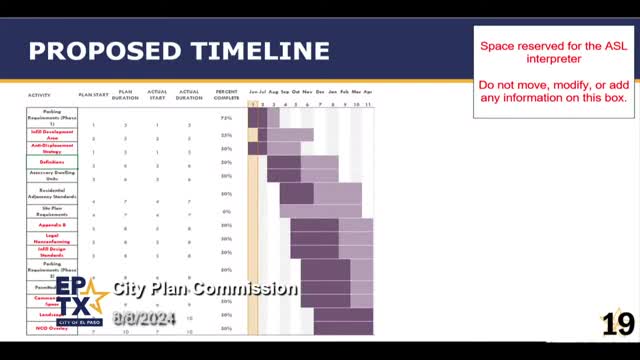City leaders clash over housing density and community concerns
August 09, 2024 | El Paso City, El Paso County, Texas
This article was created by AI summarizing key points discussed. AI makes mistakes, so for full details and context, please refer to the video of the full meeting. Please report any errors so we can fix them. Report an error »

In a recent government meeting, officials discussed the development of new regulations aimed at increasing density in local neighborhoods while addressing community concerns about potential displacement and affordability. The conversation highlighted the importance of using existing buildings as models for new developments, ensuring that proposed changes align with the character of established neighborhoods.
One official emphasized the need for regulations that differentiate between local property owners and outside investors, expressing concern that blanket policies could favor developers who may not prioritize community welfare. The official argued for a more nuanced approach that considers the unique circumstances of long-term residents versus those looking to profit from real estate investments.
In response to these concerns, city officials acknowledged the necessity of implementing anti-displacement strategies as part of the broader planning process. They indicated that these strategies would be developed in collaboration with community development and economic development departments, aiming to safeguard existing residents as density increases.
The meeting also addressed the involvement of neighborhood associations in the planning process. Some attendees expressed frustration over a perceived lack of communication and engagement from city officials, questioning whether local voices were adequately represented in the development of new regulations. Officials reassured participants that the recommendations being considered stemmed from a collaborative effort that included input from various stakeholders, including neighborhood associations.
As the city moves forward with these regulatory changes, officials are committed to ensuring that community feedback continues to shape the implementation of policies designed to balance growth with the needs of existing residents.
One official emphasized the need for regulations that differentiate between local property owners and outside investors, expressing concern that blanket policies could favor developers who may not prioritize community welfare. The official argued for a more nuanced approach that considers the unique circumstances of long-term residents versus those looking to profit from real estate investments.
In response to these concerns, city officials acknowledged the necessity of implementing anti-displacement strategies as part of the broader planning process. They indicated that these strategies would be developed in collaboration with community development and economic development departments, aiming to safeguard existing residents as density increases.
The meeting also addressed the involvement of neighborhood associations in the planning process. Some attendees expressed frustration over a perceived lack of communication and engagement from city officials, questioning whether local voices were adequately represented in the development of new regulations. Officials reassured participants that the recommendations being considered stemmed from a collaborative effort that included input from various stakeholders, including neighborhood associations.
As the city moves forward with these regulatory changes, officials are committed to ensuring that community feedback continues to shape the implementation of policies designed to balance growth with the needs of existing residents.
View full meeting
This article is based on a recent meeting—watch the full video and explore the complete transcript for deeper insights into the discussion.
View full meeting
